Tag Archives: carved
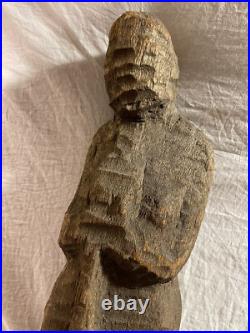
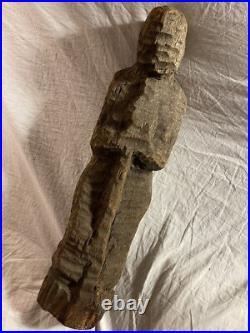
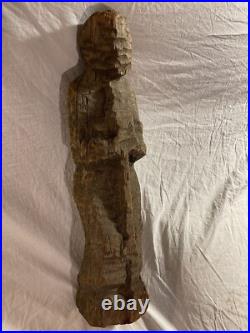
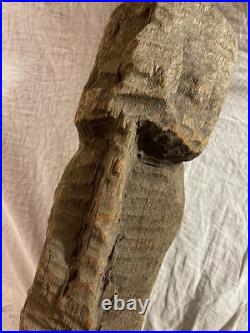

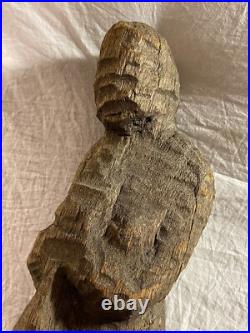
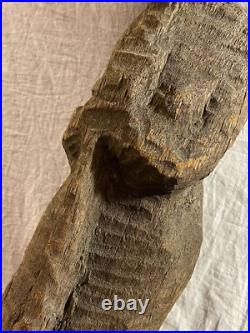
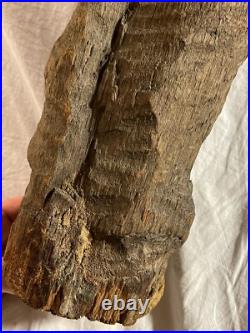
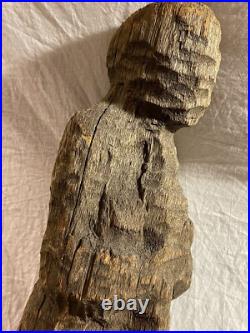
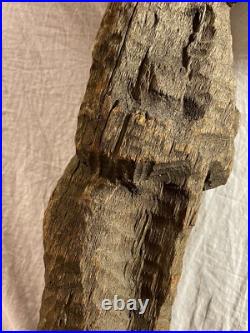
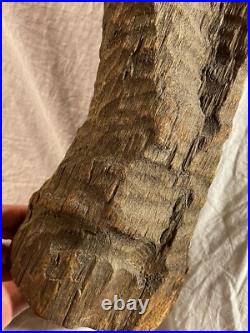
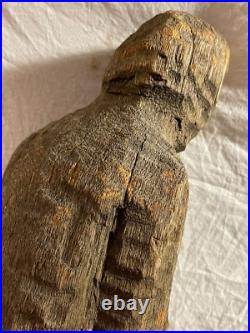
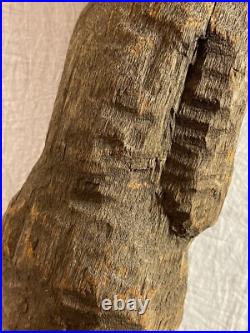
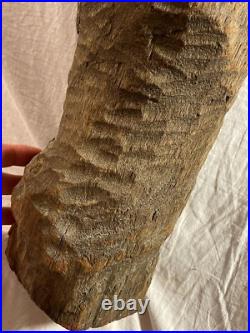
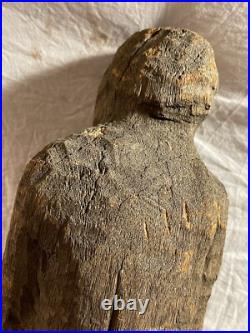
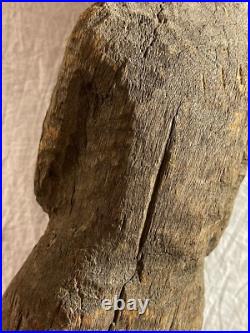
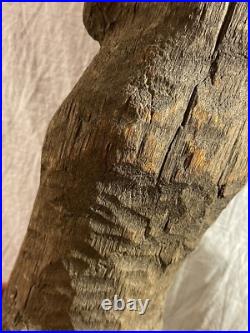
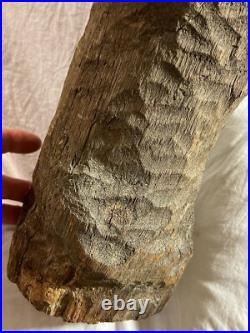
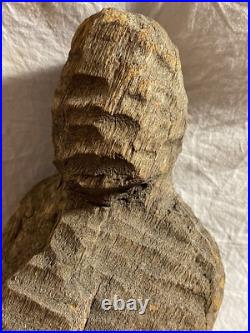
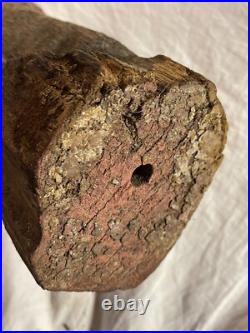

Vintage Carved Wooden Abstract Sculpture original folk outsider art. Very cool Figural sculpture in wood. Spectral form, I have a couple of ideas of what it looks like but I’d rather not take away from its abstract beauty. Interesting form either way, heavy chip carving throughout with cracks and nice old surface. Tough to date, appears to have good age but no signature or date. Please use photos and zoom feature for most accurate condition. Measures about 19.75″ by about 5″ wide and about 4.75 deep. One of one, beautiful, a guaranteed conversation piece and sure to be the only one on your block. Please get them approved before purchasing. Any questions must be answered before the sale. Almost everything I offer is old and has likely spent time in a basement or garage. I do my best to get back to everyone in a timely fashion. If you don’t hear a response within 48 hours please ask question again! Also, make sure to check my other listings for more great vintage finds- I will certainly do my best to work with you if you are purchasing multiple items. I love old things so I’m always hunting through auctions, flea markets & yard sales for the ultimate score. I often buyout entire estates, which is why I have such varied offerings. I love bringing the old and unique back to market & I’m constantly adding inventory so please check back often. You never know what I’ll find next!

Recent Posts
- 4-Piece Wood Carving Tool Set with Leather Roll Hand Forged Axe
- Mid 20th Century Vintage Hand Carved Pine Horse Head Sculpture
- Chinese Antique Boxwood Wood Carving Exquisite Tiger Statue Wooden Sculpture Art
- Vintage Carved Wood Sculptures. 10.5in Tall Handcrafted Figural Statues
- Fertilidad del Tiempo Hand-Carved Wood Sculpture by Tony Jimenez Pick Up in AZ
Archives
- November 2025
- October 2025
- September 2025
- August 2025
- July 2025
- June 2025
- May 2025
- April 2025
- March 2025
- February 2025
- January 2025
- December 2024
- November 2024
- October 2024
- September 2024
- August 2024
- July 2024
- June 2024
- May 2024
- April 2024
- March 2024
- February 2024
- January 2024
- December 2023
- November 2023
- October 2023
- September 2023
- August 2023
- July 2023
- June 2023
- May 2023
- April 2023
- March 2023
- February 2023
- January 2023
- December 2022
- November 2022
- October 2022
- September 2022
- August 2022
- July 2022
- June 2022
- May 2022
- April 2022
- March 2022
- February 2022
- January 2022
- December 2021
- November 2021
- October 2021
- September 2021
- August 2021
- July 2021
- June 2021
- May 2021
- April 2021
- March 2021
- February 2021
- January 2021
- December 2020
- November 2020
- October 2020
- September 2020
- August 2020
- July 2020
- June 2020
- May 2020
- April 2020
- March 2020
- February 2020
- January 2020
- December 2019
- November 2019
- October 2019
- September 2019
- August 2019
- July 2019
- June 2019
- May 2019
- April 2019
- March 2019
- February 2019
- January 2019
- December 2018
- November 2018
- October 2018
- September 2018
- August 2018
- July 2018
- June 2018
- May 2018
- April 2018
- March 2018
- February 2018
- January 2018
Categories
- 100×100
- 10pc
- 11-foot
- 110220v
- 110v
- 11ancient
- 11vintage
- 12-piece
- 125x85x6
- 12in
- 13-foot
- 1300x2500mm
- 14th
- 14vintage
- 1500mw
- 15×39
- 1610500mw
- 16th
- 17-inch
- 17th
- 1800s
- 1870's
- 18th
- 18th-19th
- 1900's
- 1920s
- 1930's
- 1940-50's
- 1950's
- 1950s-60s
- 1960s
- 1970s
- 1980s
- 19th
- 2-hand
- 20pc
- 20th
- 220v
- 227''
- 23-inch
- 23pair
- 24×40
- 2500mw
- 255h
- 26×17
- 28four
- 28×20
- 2pcsteak
- 3-axis
- 3000mw
- 300w
- 3040t
- 30hrs
- 31-24
- 31-24odin
- 31-24wood
- 32in
- 34-inch
- 35-inch
- 35×13
- 35x60cm
- 3axis
- 4-feet
- 4-piece
- 40''
- 4pcs
- 5065cm
- 53151cmworld
- 56-40wood
- 60cm
- 6pcs
- 87cm
- aafa
- abstract
- acanthus
- adam
- addis
- adorable
- adrian
- adrien
- affordable
- african
- agnes
- alabama
- alaska
- alberdi
- alchemy
- alebrije
- alexander
- alfredo
- alice
- alien
- almost
- altar
- alva
- amazing
- american
- ancient
- andre
- andy
- angel
- angels
- anglo
- animal
- animals
- anique
- annunciation
- anri
- anri-ferrandiz
- anteater
- antelope
- antique
- antique18c-
- antiquevintage
- antonio
- anubis
- apache
- arabian
- arbortech
- archangel
- archie
- archipelago
- archipenko
- architectural
- arizona
- armadillo
- arnold
- arthur
- artisan
- artist
- artistic
- ascension
- ashanti
- asherah
- ashley
- asian
- asis
- asmr
- assembled
- assorted
- atlant
- atomstack
- atqe
- attempting
- australian
- authentic
- automatic
- awesome
- axel
- axis
- aztec
- baby
- backgammon
- badger
- baga
- bagus
- bald
- bali
- balinese
- balinese-goddess-legong-dancer-statue-carving-sculpture-carved-wood-bali-art
- ball
- baluster
- bandsawing
- barbara
- barn
- baroque
- barry
- bastet
- bath
- bayfield
- beach
- bear
- beautiful
- beautifully
- beaver
- beavercraft
- beginner
- believe
- bellamy
- benin
- bergland
- bergner
- best
- betta
- bhumisparsha
- biblical
- bigfoot
- bighorn
- bikers
- bill
- billy
- biomorphic
- bird
- birds
- birth
- bison
- bizarre
- black
- black-capped
- blackamoor
- blair
- blas
- blessed
- blessing
- blow
- blue
- boar
- bois
- bone
- bonsai
- boomer'spirit
- bordet
- boruca
- boston
- bottle
- bowl
- bowtie
- boxed
- boxwood
- breathtaking
- brienz
- brown
- bruce
- bruno
- brutalist
- bryan
- bubut
- buck
- buddha
- buffalo
- build
- builds
- bukvall
- bull
- bural
- butch
- c17th
- c18th
- caballito
- calm
- cara
- cardinal
- caribou
- carl
- carol
- carolina
- carousel
- carter
- carve
- carved
- carver
- carvers
- carvers-hand
- carvewright
- carving
- casas
- casket
- castle
- catholic
- cattle
- cedar
- century
- ceremonial
- cest
- chaim
- chain
- chainsaw
- chameleon
- charatan
- charles
- charming
- chars1934
- cheerful
- cherries
- cherry
- chester
- chickadee
- chicken
- child
- china
- chinese
- chisel
- chris
- christ
- cigar
- circa
- circle
- clark
- claude
- clearance
- client
- clock
- clocks
- cnc3018
- coal
- cocobolo
- collect
- collectible
- collectibles
- collecting
- collection
- color
- colorful
- comical
- commission
- competition
- connie
- contemporary
- copper
- cork
- corpus
- costa
- cougar
- country
- couple
- cowboy
- coyote
- crafting
- crafts
- craftsman
- craig
- crappie
- creality
- create
- creating
- creative
- cross
- crow
- crowned
- crucifix
- crusaders
- cuckoo
- custom
- cutco
- cute
- cutthroat
- cypress
- daibusshi
- dalin
- dangerous
- daniel
- danish
- dante
- dastra
- dave
- david
- davis
- dbxcutter
- death's-head
- deborah
- deco
- decor
- decorative
- decoy
- deer
- delbert
- deluz
- demetz
- demon
- dennis
- dental
- desktop
- detailed
- devil
- dewi
- diego
- different
- digs
- diorama
- disney
- divine
- djembe
- dodo
- dogon
- doll
- dolphin
- dominican
- donna
- door
- double
- dragon
- dragoncarved
- dragonfly
- drake
- drakes
- drapery
- dremel
- drift
- driftwood
- driftwoodart
- druids
- drumm
- duane
- duck
- durga
- dust
- eagle
- early
- earth
- earthy
- easily
- easley
- easy
- ebony
- elder
- electric
- elegant
- elephant
- elephants
- elijah
- elmer
- elmore
- embracing
- emil
- emily
- england
- engraving
- entry
- epoxy
- erawan
- eric
- ernesto
- erotic
- escultura
- estate
- eternal
- ethnographic
- european
- evans
- evelyn
- evening
- exceptional
- exotic
- expert
- exquisite
- extra
- extraordinary
- extreme
- extremely
- ezgeberge
- fabulous
- face
- fair
- fairy
- fairyhouse
- fantastic
- farmer
- fastest
- favorite
- feast
- feather
- female
- fertilidad
- fierce
- filigree
- filipino
- fine
- first
- fish
- fishing
- flanders
- flexcut
- flight
- floating
- flock
- floral
- flower
- flying
- focusable
- folk
- folkloric
- foot
- foredom
- forged
- formal
- found
- four-poster
- fractal
- fragrance
- frame
- framed
- francis
- frank
- franz
- frederick
- free
- freedman
- french
- friendship
- full
- gamelan
- ganapati
- gandalf
- ganesh
- ganesha
- garuda
- gator
- gemini
- gene
- génie
- geoffrey
- geometric
- george
- georgian
- gert
- giant
- gilded
- gilted
- giovanni
- giraffe
- giuseppe
- glenn
- gluing
- gnome
- goat
- goddes
- godzilla
- goku
- gold
- gold-color
- golden
- gorgeous
- gothic
- gouge
- graff
- gransfors
- gray
- grbl
- grean
- great
- green
- grey
- griffin
- gryphon
- guanyin
- guardian
- guatemalan
- guge
- guide
- gunnar
- guru
- haitian
- halali
- halloween
- hammerhead
- hand
- hand-carved
- hand-carved-wood-saint-sculpture
- hand-made
- handcarved
- handcraft
- handcrafted
- handicrafts
- handmade
- handstand
- hanging
- hansen
- hanuman
- happy
- hardest
- hares
- haunted
- havel
- hawaiian
- hawk
- head
- headboard
- headed
- healthy
- hear
- heart
- heavy
- heirloom
- helvie
- henckels
- henri
- henry
- high
- hindu
- hoch
- holy
- holzschnitzerei
- honduras
- hooded
- hopi
- hornbill
- horse
- hosfeld
- hours
- house
- howard
- howling
- huge
- hulk
- human
- humpback
- hunt
- hunter
- hunting
- hurdy
- hutsuls
- icon
- iconic
- iconostasis
- igorot
- iguana
- ildefonso
- image
- immaculate
- imposante
- impresionantes
- impressive
- inch
- inches
- incredible
- indian
- indio
- indonesian
- infant
- infinite
- intaglio
- intricately
- intriguing
- intro
- inuit
- iron
- ironwood
- italian
- italy
- jack
- jacques
- jade
- jaguar
- jaipur
- jamaican
- jamie
- japan
- japanese
- jason
- jazz
- jeanne
- jeff
- jere
- jesus
- jinan
- joaquin
- jockey
- joesue
- johannes
- john
- jorge
- jose
- joseph
- journey
- jubilee
- julius
- jumanji
- jumbo
- june
- jungle
- junior
- kachina
- kanok
- kansas
- katlot
- kentucky
- khmer
- killer
- kind
- king
- knife
- knight
- knives
- koala
- kobe
- koppy
- krawchuk
- krishna
- krogens
- kruzifix
- kumara
- kunz
- kutzall
- kwakiutl
- kwan
- lacque
- lacquer
- lady
- lama
- laminated
- large
- largemouth
- largest
- larry
- laser
- last
- leaf
- leafy
- learn
- learning
- leather
- lemur
- leonardo
- leroy
- lester
- lewis
- life
- life-like
- life-size
- lifesize
- lilith
- linaloe
- lion
- lion's
- living
- lobster
- logger
- long
- lonnie
- lord
- lords
- lotus
- louis
- louisiana
- lovely
- lucky
- luis
- luxury
- lynx
- machine
- made
- madonna
- maestro
- magia
- magic
- magnificent
- mahatma
- majestic
- make
- makie
- making
- makonde
- male
- malin
- mandala
- mandarin
- manzanita
- maori
- maple
- marco
- mark
- markus
- marley
- marples
- mary
- masara
- masonic
- massim
- massive
- master
- mastercarver
- matt
- mayan
- mcneill
- medallion
- medieval
- medusa
- meiji
- mermaid
- metal
- mexican
- mexico
- michael
- micro
- mid-century
- midcentury
- mieczyslaw
- millers
- mini
- minnie
- mirrored
- miss
- mitsuaki
- möbius
- mod2
- modern
- modernist
- monkey
- months
- monumental
- moon
- mora
- morchella
- most
- mother
- motorcycle
- mule
- mullanium
- multi
- multimedia
- museum
- mystery
- nagu
- nahual
- namaste'
- nancy
- narex
- narwhal
- native
- nativity
- natural
- nature
- nautical
- neil
- neje
- nest
- netsuke
- never
- nice
- nichiren
- nine
- nintendo
- nirvana
- nocturnal
- north
- northstar
- northwest
- nude
- oaxaca
- oaxacan
- oberl
- octopus
- oddities
- odin
- olive
- omtech
- one-of-a-kind
- only
- ooak
- opossum
- orange
- orca
- original
- ortur
- otter
- otto
- outsider
- ozark
- pablo
- pacific
- paete
- pair
- paire
- pairvintage
- palau
- palini
- panama
- panel
- pantera
- panti
- paraguayan
- park
- parrot
- patricia
- paul
- peaceful
- peacock
- peacocks
- pear
- pearched
- pedro
- penis
- pennsylvania
- perched
- peregrine
- perfectly
- persian
- pessolano
- peter
- petrified
- pfeil
- pheasant
- philip
- philippines
- phyllis
- physical
- piece
- pieces
- pierced
- pieta
- pillar
- pinal
- pinocchio
- pintail
- pitz
- plants
- plantsvszombiestimothy
- polar
- polychrome
- poor
- porcupine
- portland
- possum
- power
- powerful
- pre-sale
- premium
- prepare
- primitive
- process
- professional
- pudge
- puerto
- puffer
- puffin
- puppies
- purple
- putti
- puttiangels
- python
- quality
- quintessential
- quixote
- rabbit
- raccoon
- rafael
- raikes
- rainbow
- ralph
- rama
- ramelson
- ramirez
- rare
- rare-1958
- rareantique
- rarevintage
- raven
- raymor
- reading
- real
- realistic
- reclaimed
- rectangle
- red-winged
- redefine
- reducedset
- redwood
- reeder
- reel
- reinaldo
- relaxing
- relief
- religious
- remembering
- renaissance
- repairing
- resin
- restoration
- retro
- reupholstered
- review
- rhino
- rhinoceros
- ribbon
- ribon
- richard
- rick
- rita
- robby
- robert
- rochester
- roger
- rooster
- root
- rose
- rosette
- ross
- rotarex
- rotary
- rotating
- router
- royal
- ruby-throated
- running
- rupicola
- russet
- rustic
- rutledge
- ryobi
- ryoma
- sacred
- saint
- saitama
- sakyamuni
- salazar
- sale-
- samuel
- samurai
- sansone
- saraswati
- sarreid
- satisfying
- schmuckvolle
- scorpion
- screech
- scroll
- sculpted
- sculpting
- sculptor
- sculpture
- seagulls
- seated
- serene
- sergey
- sergio
- seven
- sexy
- shandley
- shane
- shaping
- shark
- shattered
- shell
- shetani
- shinta
- ship
- ships
- shou
- showy
- shun
- sicilian
- signed
- simple
- sirpiworks
- sistine
- site
- sjobergs
- skeleton
- skinny
- skip
- skull
- small
- smoking
- snail
- snake
- snow
- socle
- solid
- sono
- sorrow
- southeast
- southwest
- southwestern
- span
- special
- spectacular
- spectraply
- speed
- spent
- spiral
- spirit
- spoon
- square
- squirrel
- stained
- stan
- stand
- stanley
- start
- started
- stations
- statue
- statues
- statutes
- steampunk
- steel
- steelhead
- stephen
- steps
- steve
- stop
- strange
- strawser
- striking
- stubaiaustria
- study
- stump
- stunning
- stylized
- sunburst
- super
- superb
- superbly
- superbly-carved
- svante
- swamp
- swedish
- swiss
- syroco
- szczepanik
- taber
- table
- take
- taking
- talented
- tall
- taurus
- taylor
- teaching
- teak
- teakbrass
- teakhaus
- tears
- teddy
- tempting
- tempus
- tested
- tête
- texan
- thai
- thaiburmese
- thailand
- thep
- thick
- thin
- thinker
- thomas
- thoughtful
- thrace
- three
- tibet
- tiki's
- time
- timmy
- tinsley
- tiny
- totem
- toucan
- traditional
- tragic
- trail
- transforming
- transforms
- trapper
- tree
- trés
- tribal
- tried
- triumphant
- tropical
- trygg
- turn
- turned
- turning
- turquoise
- turtle
- tutorial
- twin
- twisted
- ukrainian
- ultimate
- unbelievable
- Uncategorized
- uncle
- unicorn
- unique
- universe
- unleash
- unsigned
- unusual
- upgrade
- used
- utrecht
- uttermost
- valencia
- vegeta
- veiled
- vendome
- very
- vevor
- vibrant
- victor
- victorian
- vigilant
- vikings
- vintage
- vintageantique
- vintge
- virgin
- vitarka
- vntg
- vtge
- vulture
- walking
- wall
- wallace
- walnut
- wara
- warren
- waving
- wayan
- weathered
- weed
- welcome
- welliver
- west
- westermann
- western
- whale
- whales
- wharton
- whimsical
- white
- whitetail
- whittle
- whittling
- wholesale
- width
- wild
- wildlife
- william
- winged
- winter
- witco
- wizard
- wolf
- woman
- women
- wonderful
- wood
- woodcarving
- woodcarvingtools
- wooden
- woodpecker
- woodriver
- woodturner
- woodturning
- woodworking
- world
- wusthof
- wwii
- xiang
- y1120
- yantra
- year
- yeti
- yoitarikikougyou
- york
- yoruba
- yoshinaotamahagane
- zapotec
- zbor
- zelkova
- zwarte
